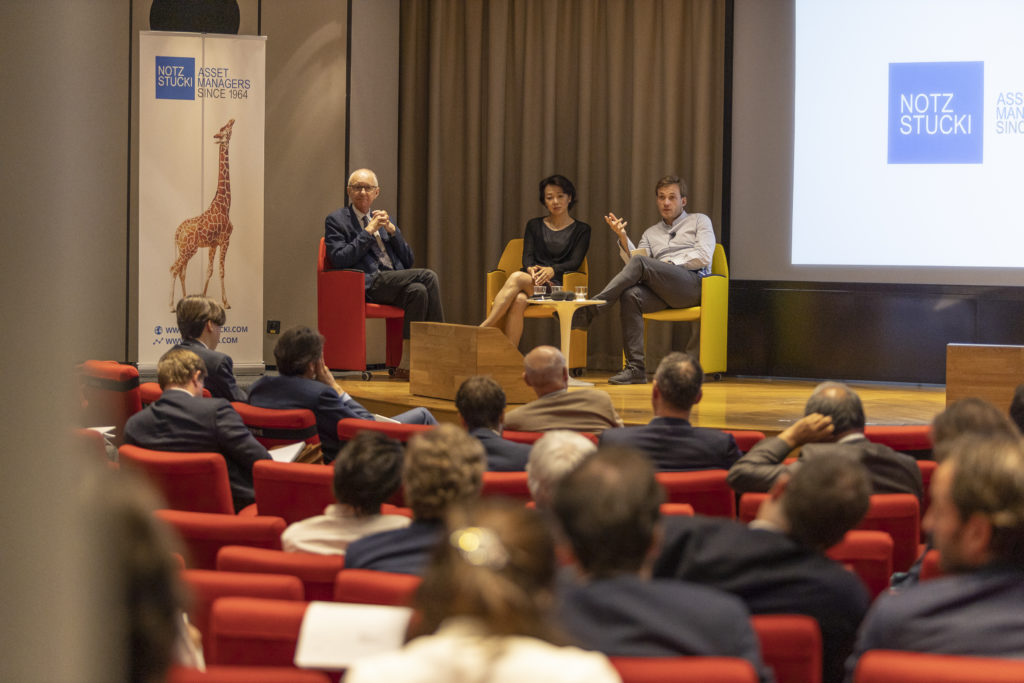Notz Stucki Investment Conference – 25 June 2019
The central question that the presentation addressed was whether the difficult conditions of last year were a buying opportunity, or whether they were the start of a longer, deeper downward phase from a combination of the Federal Reserve tightening policy and the disintegration of politics in Europe and elsewhere. By the end of last year it certainly felt as though change was in the air. With the recovery in markets this year the situation is poised between the two views; markets have rallied but not to their old highs. A further question that was covered was the apparently opposing signals being sent by the equity and bond markets, with equities pointing to economic expansion and bonds to recession. In preview Anatole’s conclusion was that the 2018 setback did provide buying opportunity similar to that offered by the market falls in 2011/12 and 2016, and that rather than contradicting each other the equity and bond markets are reacting to different influences.
Last year’s sell off was caused by a combination of political traumas, a rising oil price and tightening monetary policy. All three of these factors abated in the early part of 2019. The aggressive political rhetoric was toned down, oil prices fell back and the Fed reversed its tightening stance. While the first two of these have been clouded recently the overall situation is much more positive for markets, particularly with the Fed’s unambiguous change of posture to be more accommodative. The trade dispute and Iran situation are unpredictable and add uncertainty, but the crucial thing for markets is that monetary policy is sufficiently stimulative to support them. This should give investors the confidence to keep their risk positions on.
The main threat to this scenario is that the world falls into recession. The bond market’s action recently seems to be indicating that this is likely. However outside of Europe a recession is a very low probability. The global economy remains strong, with no sign of stagnation. World growth is about 3.6% – bang in line with the ten-year and thirty-year average. The composition of this growth has shifted to the Emerging Market bloc providing more of the growth than the US and Europe, but the overall rate of growth remains healthy. This is what matters for globally active companies – lots of new purchasing power is being created and they benefit from this. The strong performance of equities reflects this. China has been particularly dominant in supporting this growth, having taken strong measures early in the year to maintain their economy. As a result the trade dispute has not had much impact on overall growth. The one region that has suffered a dramatic downgrade in growth is Europe. As a bloc the Eurozone has been downgraded by -0.6%, and within that Germany has been marked down by -1.1% and Italy -0.9%, and these markdowns come off already weak levels. The anaemic economic situation, exacerbated by difficult politics is the largest risk to world growth. Worse, Europe’s problems are hard to resolve. Structurally Europe’s economy is more exposed to world trade, and therefore any slowdown in global trade affects it more. In particular the auto industry, an important sector for Germany, is in the eye of the trade storm. Second Europe’s policy response to its slowdown has been less coherent than elsewhere. The Maastricht rules mean that when the economy slows it leads to a fiscal tightening, and the weakness of Europe’s financial system leads banks to lend less. On top of it all Europe has considerable political uncertainty with issues in almost every country beyond the unresolved Brexit situation.

Why then do bond markets continue to record such low yields? While economic growth has remained steady, for inflation and interest rates there has been a spectacular change. In the last decade, inflation has fallen to around the 2% level, compared to a level of about 6% in the previous two decades. There has been a structural change in inflation and this is what the bond market is picking up. This year what has driven the bond market even higher has been the Fed showing signs of becoming outright supportive of markets in the way that the Bank of Japan and European Central Bank have been over the last few years. They have made it clear that there will be no monetary tightening for the time being, if anything the Fed will ease policy. So equities and bonds may not be as contradictory as many commentators suggest. The equity market is responding to the growth the world is enjoying, and the bond market to the dovishness of the Central Banks.
For investors the key point is that if there is no US recession there will not be a bear market, and a recession looks unlikely in the next two years. Clearly fiscal policy won’t be tightened and it is unlikely that monetary policy will be. Such loose conditions provide a benign environment for equities. Indeed given such unprecedentedly low bond yields equities look reasonably valued. US equities are on higher ratings than elsewhere so it makes sense to diversify out of the US. Given the problems of Europe this argues for a greater allocation to Emerging Markets as a warrant on continued growth. This view also extends to currencies where the US dollar is looking expensive, while the yen and the Emerging Market currencies are looking cheap. At current yields it is hard to make a case to invest in bonds, and if the data continues to be strong then the best way to hedge an equity portfolio from here might be to go short the bond market.
Through their presentations, our guest speakers offered a concise and readily applicable overview of the recent developments in financial markets.

Please click here to access the speakers’ presentations.